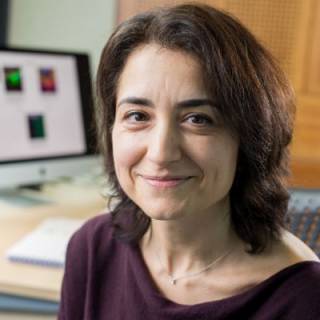Professor Simona Parrinello is studying stem cells in the brain - both those that generate new neurons and the cancer stem cells that make glioblastomas so hard to treat.
Professor Parrinello, who recently moved from Imperial College to UCL, has uncovered some of the fundamental mechanisms by which tissue microenvironments promote wound healing. Key to this process is the reprogramming of cell fate by microenvironmental signals [1].
At UCL, she is drawing on this experience in her research on neural stem cells and the cancer stem cells found in glioblastomas. Neural stem cells persist in restricted areas of the adult brain, such as the hippocampus and the lining of the brain's ventricles (the subventricular zone), where they normally exist in a quiescent state until they activate and produce new neurons and glia.
Notably, Professor Parrinello and colleagues have shown that stem cell quiescence is dependent on an intimate physical connection between quiescent stem cells and blood vessels in the subventricular zone [2]. These connections are mediated by two proteins on the surface of cells lining blood vessels - ephrinB2 and Jagged1 - which promote the expression of 'stemness' genes in quiescent cells and block signals that normally initiate cell division.
However, in glioblastoma, stem-like cells have subverted this mechanism of control. Glioblastoma is difficult to treat because cancer cells typically disperse through the brain, migrating along tracts such as blood vessels, which makes it hard for surgeons to remove all cancerous tissue. Furthermore, the disseminating cells are typically stem-like and can seed recurrent tumours. Professor Parrinello and colleagues have found that the ability of stem-like tumour cells to travel along blood vessels depends on their upregulation of ephrinB2 [3]. It also enables them to divide without attachment to a cellular substrate, providing them with more freedom to proliferate. Targeting ephrinB2 could therefore prevent dissemination of glioblastoma and inhibit cancer cell proliferation.
In her new lab, Professor Parrinello is now seeking to understand more about the intercellular interactions that support the migration of stem-like glioblastoma cells, and how they are able to migrate along white matter tracts, a further route by which they can disseminate through the brain. She also hopes to determine precisely how migrating cells differ from both normal neural stem cells and other glioblastoma cells.
- Clements MP et al. The wound microenvironment reprograms Schwann cells to invasive mesenchymal-like cells to drive peripheral nerve regeneration. Neuron. 2017;96(1):98-114.e7.
- Ottone C et al. Direct cell-cell contact with the vascular niche maintains quiescent neural stem cells. Nat Cell Biol. 2014;16(11):1045-56.
- Krusche B et al. EphrinB2 drives perivascular invasion and proliferation of glioblastoma stem-like cells. Elife. 2016;5. pii: e14845.
 Close
Close


